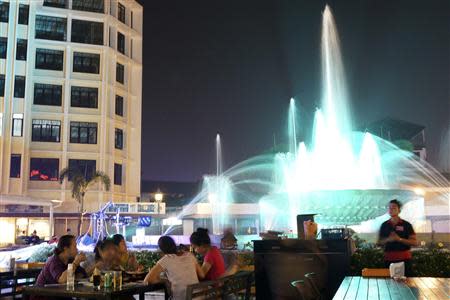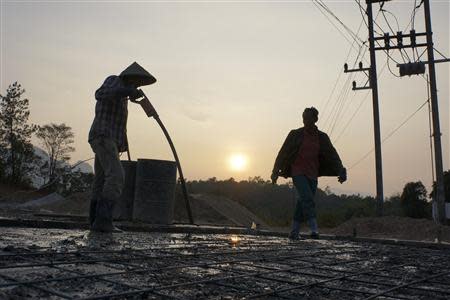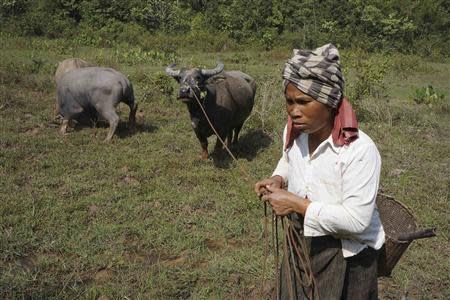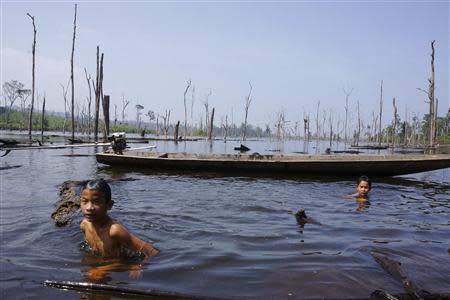Economic fears expose Laos' unequal boom
By Aubrey Belford and Amy Sawitta Lefevre VIENTIANE (Reuters) - For the Communists running Laos, the fruits of capitalism have never been so bountiful. The Nam Phou fountain at the heart of the torpid capital, Vientiane, has transformed from a relic into a neon-lit phantasmagoria, surrounded by expensive restaurants. On the increasingly congested roads, the elite car choice is a Range Rover or, failing that, a Lexus. This is the result of years of more than 8 percent growth, driven by commodities exports and a flood of investment from neighbouring China, Thailand and Vietnam. The Laos stock market, the world's smallest, made its coy debut in 2011. The boom in Laos, one of Asia's poorest countries, is not over, but serious cracks are starting to show. Economists warn the country of 6.7 million is facing the downside of a development model based on easy credit, resource exploitation and infrastructure mega projects. "The economy is overheating," Ashvin Ahuja, who led an International Monetary Fund (IMF) delegation to Laos in September, told Reuters. The IMF has identified a range of problems. A shortfall in government revenues coupled with ballooning expenditure - particularly rises in pay to public servants - has seen the fiscal deficit rise to about 6.5 percent of GDP. Inflation is projected to rise to about 7.5 percent by the end of the year, and up to 9.4 percent next year. The country's foreign exchange reserves are enough to cover just 80 percent of one month's imports. Western banking and business sources, who insisted on anonymity, told Reuters that there had been a shortage of U.S. dollars for several months. On the streets of Vientiane, frustration is growing as prices rise and incomes become precarious. In August, a kilo of pork sold by Chantara Phommavongsee at Vientiane's Thong Kan Kham market went for 68,000 kip, or about $8.60, she said. Fast-forward four months and it was selling for 75,000 kip. Civil servants are coming less often - the government had not paid them in months. The black economy, meanwhile, is thriving. On weekends, smart customers drive across the Mekong River to Thailand, where prices are cheaper, Chanthara said. Some come back with goods for sale. "Cars, food, medicine, building materials," Chantara reeled off the list. "All Thai." The normally reticent and secretive government appears to be listening. Prime Minister Thongsing Thammavong warned in September that "Laos is running a high level of debt and is at risk of a financial crisis" and ordered ministers to cut costs, according to the state-run Vientiane Times newspaper. The government has delayed payments to some contractors, promised to curb salary rises and suspended a 760,000 kip monthly allowance for civil servants. These measures have been welcomed by the IMF. But the fund has warned a major change of course is needed if the country wants to keep growing in the future. MISSING OUT Beneath the warnings of economists, there is a deeper critique from some quarters on the Lao development model: that the country is squandering its natural wealth and enriching its elite, while the majority is left behind. One of the country's traditional wealth generators, resource extraction, faces entrenched corruption. Commodities such as rubber and timber often pass out of the country with little or no tax being paid, thanks to an opaque network of political connections. At the same time, black market imports are flowing. "Although all traditional economic indicators say Laos is doing okay, Laos is getting screwed," a senior member of the Western business community in Vientiane told Reuters. "Laos is missing out on an unquantified - by anyone, not the IMF, not the World Bank, anyone - amount of revenue." Optimists point to headline figures, such as a one-third decrease in the poverty rate in the 15 years to 2008. Pessimists focus on other indicators: the tiny landlocked country has Southeast Asia's highest incidence of child mortality and one of its lowest school enrolment rates. The government is staking much of its future on large-scale infrastructure projects, including multi-billion dollar road and high-speed rail links intended to turn Laos into a crossroads of China, Thailand and Vietnam. Even more ambitiously, the country is seeking to become "the battery of Southeast Asia" through the construction of a series of massive dams on its pristine rivers, despite howls of protest from environmentalists. The government plans to export most of the electricity. There are 13 dams operating in the country, and another 70, such as the giant Thai-funded Xayaburi dam on the Mekong, in the construction, planning or feasibility stages. The country aims to produce 12,500 megawatts of power by 2020. Julian Newman, campaigns director at the London-based Environmental Investigation Agency, says many projects face the same problems that have plagued the export of commodities, with kickbacks and benefits flowing to business people and their allies in the Communist Party and government. In some cases, contractors can earn a healthy sideline in illegally clearing forests near projects, Newman said. Viraphonh Viravong, Laos' Vice Minister of Energy and Mines, said the government was serious about rooting out corruption and that banks and international donors helped ensure the transparency of large scale projects. "Wherever you go in this world, there is corruption. It exists not only in the least developed countries but in the most developed countries as well," Viraphonh told Reuters by email. Viraphonh said the government had last year imposed a moratorium on the granting of new large mining and plantation concessions, but would not rethink the pursuit of megaprojects. "The Lao PDR is duty bound, morally and politically, to continue to harness the might of the rivers that flow through our country, to power cities, electrify rural areas and generate the necessary resources to overcome poverty, malnutrition, infant mortality, illiteracy and for the greater good of our people," he said. NO RICHER If any project shows that Laos can pull off its dream of dam-based development it's Nam Theun 2, a massive 1,000 megawatt project in the country's south. With the backing of the World Bank and the Asian Development Bank, the $1.45 billion dam went into operation in 2010 with a raft of measures to mitigate its environmental impact and contribute to local livelihoods. For Nam Theun 2's backers, the project is already a success. The dam is on track to earn $2 billion for the Lao government over 25 years, with monitoring in place to make sure the money does not evaporate. For the roughly 6,000 people displaced by the dam, life has also improved, said Meriem Gray, a spokeswoman for the World Bank. Surveys done by the Nam Theun 2 Power Company found 87 percent of resettled villagers see themselves as better off, she said. School enrolments have also jumped, along with access to electricity and clean water. Environmentalists, however, say the dam has been a disaster for the displaced, as well as 110,00 people reliant on downstream agriculture and fisheries. A two-day visit by Reuters to the dam site also suggested the project's achievements have been mixed at best. Where villages once stood there is now a reservoir peppered with dead trees and stagnant water the colour of weak coffee. A narrow artificial peninsula hosts settlements for relocated locals. In interviews with Reuters, residents repeated the same complaints. Power cuts are frequent, in spite of the nearby power plant. The 0.6 hectares of land granted to each family as part of the relocation deal was not enough to live off, they said, while fishing in the reservoir was often not good enough to provide an alternative livelihood. One economic benefit that has arrived has been Laos' traditional cash cow: black market resource extraction. The project and the roads that have come with it have opened up the area to poaching and the near-eradication of valuable hardwoods from nearby forests, according to a recent independent report by a panel of experts commissioned by the World Bank. Local people admitted to taking part in the illegal logging trade around Nam Theun 2 and claimed local government officials were complicit. "We didn't have to do this before moving here because we made a good living from the land," said 43-year-old Wan, who told Reuters almost every family in his resettlement village was involved. Mixay, the 45-year-old matriarch of a family of 10 in another village, echoed the sense of disappointment. "I thought life would be much better, but it isn't at all," she said. "We're not any richer because of this dam. The only people who get anything, who get richer, are those in the government." (Editing by Jason Szep and Alex Richardson)





